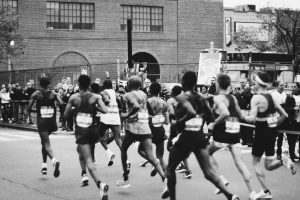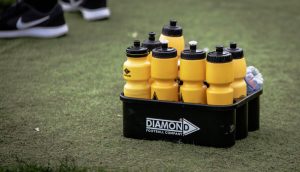By Sean Byrne, Sam Cross, Anthony Delaney, Ashley Groombridge, Katie Hickson, Louis Hunter (E119 19J Students)
This blog was written as part of a collaborative team work task by students studying E119. They had to select a topic and then decide on what roles each person would perform in the team, such as researcher, writer, editor and leader. This blog was chosen as one of the best blogs from around 80 blogs that were produced.
 On the 12th October 2019, Eliud Kipchoge, the current marathon world record holder, became the first person to run the marathon distance under two hours (1.59.40). This incredible accomplishment has been hailed as one of the most monumental milestones in running history, alongside Sir Roger Bannister’s sub 4-minute mile and Usain Bolt’s 9.58 100 metre sprint world record.
On the 12th October 2019, Eliud Kipchoge, the current marathon world record holder, became the first person to run the marathon distance under two hours (1.59.40). This incredible accomplishment has been hailed as one of the most monumental milestones in running history, alongside Sir Roger Bannister’s sub 4-minute mile and Usain Bolt’s 9.58 100 metre sprint world record.
So how did he achieve this remarkable feat? Natural talent, dedication and a gruelling training programme, with 140 miles per week, are the understandable foundations of success. Indubitably, the support from an assembled team of skilled coaches, physiotherapists, physiologists and nutritionists overseeing his training, physiological testing, hydration and nutrition strategies (INEOS159challenge , 2019) contributed immensely but what specifically turned his previous failings at the Nike Breaking2 Project, into triumph?
Course selection
The Pater, Vienna, Austria was selected as the perfect location. As one would expect, the route was carefully chosen to eliminate any directional or incline changes to maximise the runners’ economy but Team INEOS’ analysis didn’t stop there. They also considered the altitude and climate; low temperatures (around ten degrees Celsius is considered the benchmark) and low humidity is conducive to running a fast marathon due to the body working harder to regulate its temperature in hot conditions (Sharkey & Gaskill, 2013). It is also believed that running shoes lose grip during humid conditions. (INOES159challenge, 2019). The location also had to be at low altitude, even though Kipchoge lives and trains at high altitude (2400m), science suggests preparing at altitude enables the body to be better conditioned (Fudge, et al., 2018) and racing at a lower altitude whilst acclimated to high altitude will see an increase in performance (Fudge, et al., 2018)The final factor in choosing the location was the time zone difference, Vienna is just one hour behind Eliud’s home time zone- which means his sleeping, eating and training patterns would be minimally affected.
Hydration and Nutrition
As anticipated, running a marathon requires an enormous amount of energy, this energy is provided by fat and carbohydrates, metabolised aerobically. Fat is supplied from the muscle triglyceride and plasma free fatty acids (FFA), that are mobilised from adipose tissue and transported to the muscles by the circulation (Sharkey & Gaskill, 2013). Fat is the most abundant source of available energy – enough to fuel muscles to run hundreds of miles but it is slow to break down (Wright, 2018), therefore, as the intensity level increases so does the carbohydrate usage, becoming predominant at high levels of intensity (Sharkey & Gaskill, 2013) i.e. running a marathon at pace. Carbohydrate is available as glucose in the bloodstream and is also stored in skeletal muscles and the liver as glycogen (Girard Eberle, 2014). Kipchoge’s carbohydrates were topped up during the race by consuming sports drinks and energy gels produced by Maurten (Maurten, 2019).
Rehydrating during the marathon is crucial, dehydration in excess of five per cent of an athlete’s bodyweight results in a decrease in strength, endurance and work capacity (Sharkey & Gaskill, 2013). The ASCM et al. (2016) state that even though exact sweat rates vary from athlete to athlete, most athletes partaking in exercise will require an intake of 0.4 – 0.8 litres of water every hour. Kipchoge rehydrated by drinking Maurten sports drinks, a benefit of consuming a sports drink over water, is that sports drinks contain electrolytes including sodium and potassium – minerals that are crucial for the control of the flow of water in and out of cells and are vital to ensure fluid retention. Furthermore, research has shown that isotonic drinks can be absorbed faster than water alone (Wright, 2018).
Pacemakers
Sir Roger Bannister’s name is entrenched in running history, his exploit legendary yet he couldn’t have achieved the remarkable feat without being paced by friends and teammates. Eliud Kipchoge also enlisted the help of teammates, forty-one of the world’s best middle and long-distance runners to be precise (INEOS159challenge, 2019). These runners rotated at the end of each six-mile lap, followed an electric car with adapted cruise control for greater accuracy. The car projected a laser beam onto the road to keep the runners on the required pace. After extensive aerodynamic research conducted at TU Eindhoven, the pacemakers ran in a reversed V shape, with two runners running behind him, this led to a 85% reduction in air resistance (Eindhoven University of Technology, 2019).
The controversial running shoes
Nike created a bespoke, improved version of their previous Vaporfly Next% running shoes – the AlphaFLY. The AlphaFLY have four chambers containing pressurised fluid, three carbon plates and ZoomX – a lightweight foam, providing cushioning (Roe, 2019). Nike claim the shoes improve running economy by four percent and this claim has been verified by an independent study (Barnes & Kilding, 2019). A variation of the shoe has been worn by the top 10 finishers in the mens’ race at the Chicago Marathon, the following day. In addition, Brigid Kosgei, who broke Paula Radcliffe’s long standing women’s marathon world record in Chicago, also wore the shoe. Subsequently, a group of athletes complained to the IAAF about the shoes, prompting them to establish a working group to analysis the issue.
Spectators
After evaluating the Breaking2 Project’s failed attempt at Monza Racetrack, Italy, Kipchoge bemoaned the lack of spectators to support his phenomenal effort. Positive support from spectators can lead to increased performance (Lavellee, et al., 2012). During his attempt at the INEOS 1:59 Challenge, the route was lined by masses of supporters cheering him to greatness.
Unfortunately, his Herculean effort is not recognised as a marathon world record by the IAAF, due to the delivery of hydration and nutrition by bicycle, lack of open competition and rotating world class runners, working as pacemakers (BBC, 2019) but now the barrier has been broken, it’s only a matter of time before an athlete runs sub two hours during a race.
References
American College of Sports Medicine (ACSM), 2016. American Dietetic Association (ADA) and Dieticians of Canada (DC) (2016) Joint Position Statement, ‘Nutrition and athletic performance. Medicine and Science in Sports and Exercise, 48(3), p. 543–568.
Barnes, K. R. & Kilding, A. E., 2019. A Randomized Crossover Study Investigating the Running Economy of Highly-Trained Male and Female Distance Runners in Marathon Racing Shoes versus Track Spikes., Bethesda MD: National Center for Biotechnology Information.
BBC, 2019. Eliud Kipchoge breaks two-hour marathon mark by 20 seconds. [Online]
Available at: https://www.bbc.co.uk/sport/athletics/50025543
[Accessed 27 January 2020].
Eindhoven University of Technology, 2019. TU/e wind tunnel helped break the marathon’s two-hour barrier. [Online]
Available at: https://www.tue.nl/en/news/news-overview/tue-wind-tunnel-helped-break-the-marathons-two-hour-barrier/#top [Accessed 27 January 2020].
Fudge, B., Pringle, J., Maxwell, N. & Richardson, A., 2018. Altitude training in endurance running: perceptions of elite athletes and support staff. Journal of Sports Sciences, 37(2), pp. 163-172.
INEOS159challenge , 2019. Eluid’s Team. [Online]
Available at: https://www.ineos159challenge.com/team/eliuds-team/
[Accessed 26 January 2020].
INEOS159challenge, 2019. Pacemakers. [Online]
Available at: https://www.ineos159challenge.com/team/pacemakers/
[Accessed 26 January 2020].
INOES159challenge, 2019. Why Vienna proved to be the outstanding candidate to host the Ineos 1:59 Challenge?. [Online]
Available at: https://www.ineos159challenge.com/news/why-vienna-proved-to-be-the-outstanding-candidate-to-host-the-ineos-1-59-challenge/
[Accessed 27 January 2020].
Lavellee, D., Kremer, J., Moran, A. & Williams, M., 2012. Sport Psychology: Contemporary Themes. 2nd ed. London: Red Globe Press.
Maurten, 2019. SHOP SPORTS FUEL. [Online]
Available at: https://www.maurten.com/products/gb
[Accessed 27 January 202].
Roe, D., 2019. Everything We Know About Eliud Kipchoge’s Barrier Breaking Shoes. [Online]
Available at: https://www.runnersworld.com/gear/a29447426/eliud-kipchoge-shoes/
[Accessed 27 January 2020].
Sharkey, B. J. & Gaskill, S. E., 2013. Fitness & Health. 7th ed. Champaign: Human Kinetics.
Wright, N., 2018. Unit 29 How nutrition fuels the athlete’s body. [Online]
Available at: https://learn2.open.ac.uk/mod/oucontent/view.php?id=1287358
(Accessed 18 May 2019).

